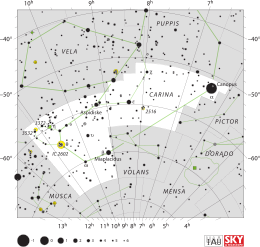HD 96566
Da Wikipedia, l'enciclopedia libera.
| HD 96566 | |
|---|---|
| Classificazione | gigante gialla |
| Classe spettrale | G8III C ~ |
| Distanza dal Sole | 370 anni luce |
| Costellazione | Carena |
| Redshift | -2,00 ± 0,90 |
| Coordinate | |
| (all'epoca J2000.0) | |
| Ascensione retta | 11h 06m 32,4279s |
| Declinazione | -62° 25′ 26,808″ |
| Lat. galattica | -01,9825° |
| Long. galattica | 291,1210° |
| Dati fisici | |
| Massa | |
| Temperatura superficiale |
|
| Dati osservativi | |
| Magnitudine app. | 4,62 |
| Magnitudine ass. | -0,65 |
| Parallasse | 8,82 ± 0,51 mas |
| Moto proprio | AR: -36,83 ± 0,48 mas/anno Dec: 9,57 ± 0,40 mas/anno |
| Velocità radiale | -2,0 ± 0,9 km/s |
| Nomenclature alternative | |
HD 96566 (z1 Carinae, z1 Car) è una stella gigante gialla di magnitudine 4,62 situata nella costellazione della Carena. Dista 370 anni luce dal sistema solare.
Osservazione
[modifica | modifica wikitesto]Si tratta di una stella situata nell'emisfero celeste australe. La sua posizione è fortemente australe e ciò comporta che la stella sia osservabile prevalentemente dall'emisfero sud, dove si presenta circumpolare anche da gran parte delle regioni temperate; dall'emisfero nord la sua visibilità è invece limitata alle regioni temperate inferiori e alla fascia tropicale. La sua magnitudine pari a 4,6 fa sì che possa essere scorta solo con un cielo sufficientemente libero dagli effetti dell'inquinamento luminoso.
Il periodo migliore per la sua osservazione nel cielo serale ricade nei mesi compresi fra febbraio e giugno; nell'emisfero sud è visibile anche per buona parte dell'inverno, grazie alla declinazione australe della stella, mentre nell'emisfero nord può essere osservata limitatamente durante i mesi primaverili boreali.
Caratteristiche fisiche
[modifica | modifica wikitesto]La stella è una gigante gialla; possiede una magnitudine assoluta di -0,65 e la sua velocità radiale positiva indica che la stella si sta allontanando dal sistema solare.
Note
[modifica | modifica wikitesto]- ^ P. Gondoin, Evolution of X-ray activity and rotation on G-K giants (PDF), in Astronomy and Astrophysics, vol. 352, dicembre 1999, pp. 217–227.
Voci correlate
[modifica | modifica wikitesto]Collegamenti esterni
[modifica | modifica wikitesto]- Dati della stella dall'archivio Simbad, su simbad.u-strasbg.fr.
Text is available under the CC BY-SA 4.0 license; additional terms may apply.
Images, videos and audio are available under their respective licenses.

